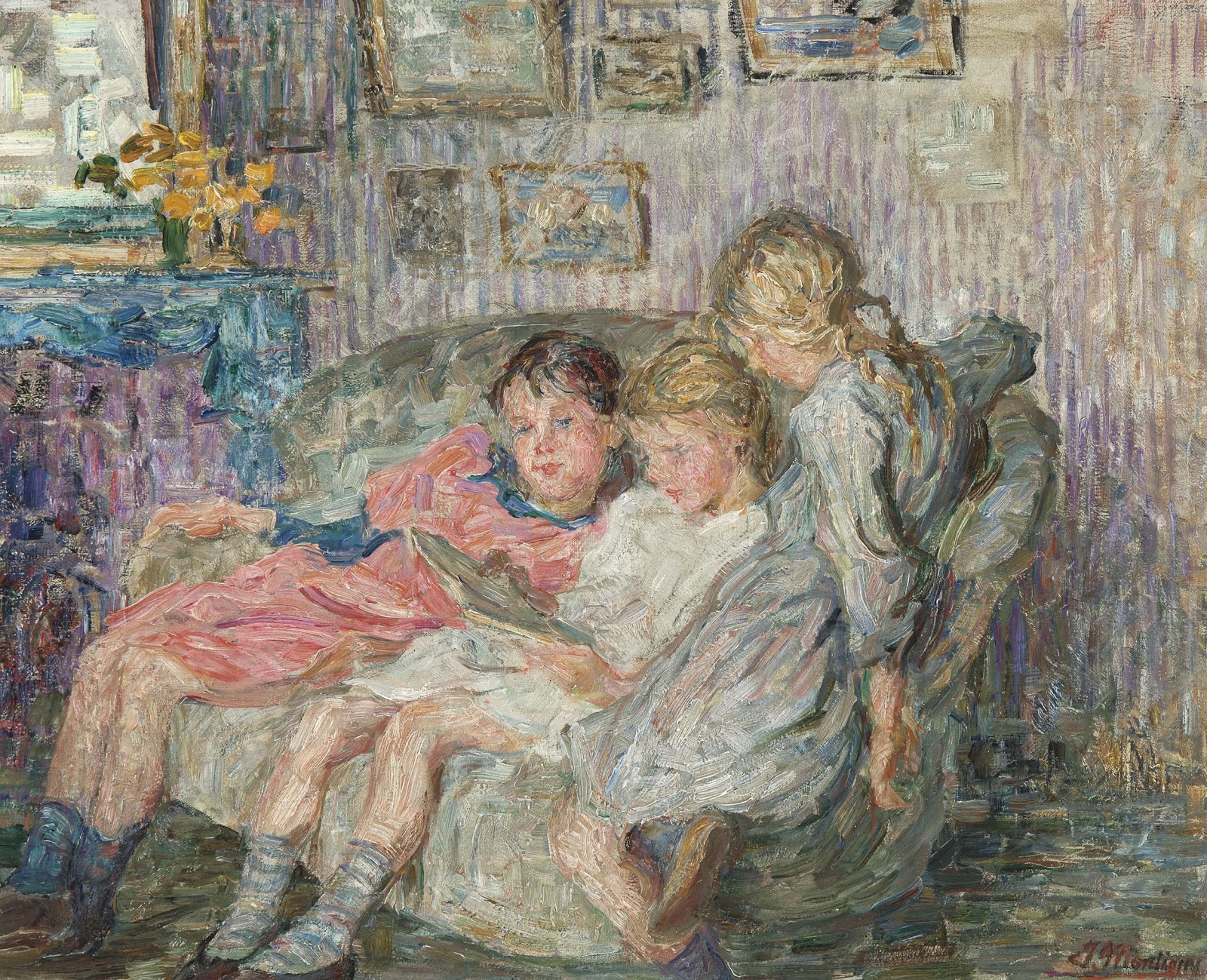Children's Minds in the Line of Fire Blog
 Reading Girls (Three sisters), Jenny Montigny
Reading Girls (Three sisters), Jenny Montigny
Hey, leave those kids to dream and play
Teresa Flores, M.D.
“I became very conscious of a wall between us and our audience, and so this record started out as being an expression of those feelings.” During one of the concerts in 1977 a fan was invited on stage and the fan spat on Roger's face. That caused Roger to feel distanced from his fans and build a wall. According to the band, the "wall" is the self-isolating barrier we build over the course of our lives, and the "bricks in the wall" are the people and events that turn us inward and away from others.
(Waters, R. (1979) “Interview with Tommy Vance” pinkfloydz.com)
Today’s children must navigate a climate of uncertainty and insecurity from the moment of birth. Surrounded by a world shaken by the looming threats of climate catastrophes, pandemics, and wars, children are burdened with the relentless demands of efficiency, perfection, and success. These pressures force them to constantly surpass themselves, leaving little room for the simple pleasures of looking, feeling, and exploring their sensorial world through contemplation and play.
The objects of a child’s affection—their parents and surrounding loved ones—are becoming increasingly unstable, dispersed, and intermittent, demanding great efforts to maintain a sense of continuity in a world marked by uncertainty. Children experience neither the time nor tranquility necessary for the development of stable primary relationships that promote growth and confident ways of exploring the environment surrounding them with confidence and curiosity for the unknown. Defensive barriers are erected, fortifying walls between self and other, or, alternatively, normalizing this lack of connection to the point where similarities and differences are no longer recognized.
The absence of a holding and containing relationship with their loved ones deprives children of the ability to transform the anguish and violence of the internal and external turmoil that engulfs them. From an early age, these children are compelled to keep up with the agitated and unstable lives of their parents, who increasingly delegate the role of education, both emotional and academic, to teachers. However, at school, they’re expected to remain calm and receptive to what their teachers impart to them. The resulting mental and physical agitation, coupled with the unavailability of those who care for them, leads to diagnoses of ADHD and to the use of medication.
Children need the time to dream. They need the time to explore the world around them in order to contemplate and assimilate experiences and sensations. However, they find themselves rushed to meet the demands of their surroundings. This raises critical questions about distinctions between a lively, alert child and one diagnosed as hyperactive.
The fragility of the child’s ego and their inability to psychically represent emotional experiences prompts various defense mechanisms, leading children to protect themselves either through agitation and aggression or through withdrawal and isolation. Sometimes the emotional turmoil, éléments β ( Bion), that overwhelms them is evacuated through the body, either by psychosomatic illness or by perverse behavior. Often these behaviors work like a cork, preventing the ego from overflowing. Other times, the ego is drained through antisocial behaviors. Excitement sometimes gives a false sense of fulfillment, filling the void of affection, belonging and protection. It is the parents' function (Bion) that will enable the development of a container and a capacity to transform the most primitive emotions, leading to the structuring of a deep sense of identity.
The virtual world of video games, for some, serves as a refuge from the unpredictable reality of daily lif. We saw this increase during the height of the global Covid-19 pandemic. In video games, children can find a fantastic reality where they can deny their small, fragile, and helpless dimension, allowing them to assume an omnipotent role—the role of the hero—and temporarily escape feelings of anxiety, abandonment, fragility, solitude, and death. This virtual world becomes a seductive, safe haven, a world of comfort and omnipotence, transmitting an illusion of stability.
John, a twenty-eight-year-old who sought solace in the virtual world, highlights how video games allowed him to deny the possibility of tragedy in his life: “I'd like to believe that time can stand still, that my parents are immortal. I've never experienced any tragedy. No one around me has died. I'd like to believe that I won't grow old… But it's impossible, and now I'm too old… I talk about myself as if I’m a man, but I'm a child.”
This short vignette clearly shows the existence of an unknown tragedy in this young man’s life. What "tragedy" was he unable to overcome, and what led him to take refuge in the virtual world of computer games?
Milner (1952) relates children playing to a crucial developmental element for people both old and young; playing concentrates in adults as the “moments when the original poet in each of us created the outside world for us, by finding the familiar in the unfamiliar.”
Play allows for the exploration of creativity, tenderness, and even hatred within a secure framework where the fear of destruction, relation, or rejection can be absent. It also provides a space for conflict resolution through displacement, without naming or addressing it directly, as doing so might have the effect of threatening intrusion, to which a child will react immediately due to its traumatic intensity.
Playing requires time: time to create a space where several different stories may be mise-en-scène. However, sometimes, inner emotional turmoil overwhelms the child’s capacity to contain and find meaning, and the only way out is to get rid of it, either through violence against others or themselves. The important thing, here, is to have an object or analyst who can receive the violence and primitive projections.
Returning to the title of this piece: I present a metaphorical interpretation of Pink Floyd and Roger Waters’ “Another Brick in the Wall,” a song that aligns with the idea that self-preservation might force an inward enclosure. If children cannot trust the world around them, they have to find ways to preserve their existence, their originality and sensibility, in a world marked by challenges to survival.
“…
playfulness throughout life is liveliness, and the lack of it causes a specific form of deadliness.
”
(Erickson, E. (1972) “Toys and Reasons” N.Y. Ed Norton)
References
Milner,M (1952). Aspects of Symbolism in Comprehension of the Not-Self Int. J. Psychoanal., (33):181-194
Winnicott, D W (1975).Through Pediatrics to Psycho-Analysis,100:306-315. Cap XXV. The Antisocial Tendency 1956. The International Psychoanalytical Library
 Maria Teresa Flores, MD
Maria Teresa Flores, MD
Psychiatrist and Psychoanalyst
Member of the International Psychoanalytical Association
Full Member and Training Analyst of the Portuguese Nucleus of Psychoanalysis (IPA Study Group)
Child and Adolescent Psychoanalyst certificate by IPA
Member of COCAP Europe (IPA Committee on Child and Adolescent Psychoanalysis)
Member of the SEPEA (Société Européenne pour la Psychanalyse de l’Enfant et de L’Adolescent)
Ex-European Co-Chair of COWAP (IPA Committee on Women and Psychoanalysis)
 Back to Children's Minds in the Line of Fire Blog
Back to Children's Minds in the Line of Fire Blog